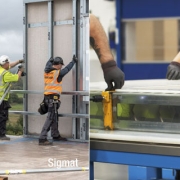One of the UK’s leading energy lawyers says the discussion on new nuclear power generation in Scotland lacks the detailed facts needed to ensure the country’s future energy security and contribute to a global reduction in carbon emissions.
Andy Renton, principal at Castletown Law, an international law firm specialising in energy and infrastructure law, said the consensus of global scientific opinion is that net zero power generation was not achievable without nuclear power.
Opponents of new nuclear power say it is environmentally damaging, poses a public safety risk and is financially unaffordable – arguments which Mr Renton said are founded on outdated information and bad data.
In advance of an event at Edinburgh’s Signet Library on May 24th, Mr Renton said an examination of the facts around new nuclear energy would demonstrate its potential role in Scotland’s and energy future.
The event will see a number of experts address an audience of industry and political attendees. Simon Stuttaford from Castletown Law will open the event, followed by George Tarambikos from Holtec Britain, a manufacturer of nuclear plant technology.
Michael Ward, from the University of Strathclyde Advance Nuclear Research Centre, will provide an overview of Scotland’s nuclear sector and the skill sectors engaged in the industry, and Remi Zante from the National Manufacturing Institute of Scotland will examine the potential for supply chain; particularly how the engineering supply chain in Scotland can participate in future domestic and international nuclear projects.
The event will look also at the potential decommissioning of nuclear power installations in Scotland and internationally.
Mr Renton said: “Nuclear energy is misunderstood. Despite being a safe, low carbon and cost-effective source of energy, it has been seen as a last resort. We desperately need to reduce our reliance on fossil fuel generation and the science shows that nuclear power, alongside renewables, is an essential part of that transition.”
In its report ‘Net Zero by 2050’, the International Energy Association (IEA), which works with global governments and industries on energy policy, said renewable energy should account for 90% of the global energy mix if net zero was to be achieved by 2050. Most of the remainder would come from nuclear power. This would require 20 gigawatts of new nuclear capacity to be added to global capacity every year between 2020 and 2050. A net total of six gigawatts was added in 2021.
According to the website fullfact.org, which checks claims made by government and other bodies, in 2020 renewables accounted for 56% of electricity consumed in Scotland, with nuclear contributing 30% and oil and gas 13%. The equivalent of 96% of all Scottish energy was generated by renewable sources, but much of this was exported.
Mr Renton said nuclear, which enables stable and dependable energy, was an essential power source which could smooth out the peaks and troughs of renewables.
He said: “The wind doesn’t always blow and the sun doesn’t always shine, as we know only too well in Scotland. Nuclear is a safe, clean and cost-effective way of ensuring sustainable and reliable power without having to rely on hydrocarbons.
“This isn’t about one clean energy source versus other. It’s about focusing on creating a sustainable energy mix for the planet which gets us to net zero in an acceptable timeframe. Fossil fuels are stable and well-tested but contribute to air pollution and carbon emissions. Taking them out of the mix means they have to be replaced by something else – new nuclear capability lets us balance the energy mix with renewables.
“Providing a long-term dependable power source at a predictable cost for the next 50-60 years is a vital component to investment in industry and economic growth. This applies everywhere, not just in Scotland, and the project demand for power generation in the coming 10 years is multiples of current production capability.
“The objective must be not to supplement existing fossil fuel generation, but to replace it and provide low carbon power generation for future needs. These needs will include significant power consumption in the production of green hydrogen as a complimentary low carbon fuel source to nuclear.”
Other claims by opponents of nuclear power are that building new nuclear sites is more expensive than other generation methods, and that the risk to life is far greater in comparison to renewables in particular.
However, analysis of IEA data, based on almost 240 power plants across the world, showed the lifetime cost of energy – including construction and power production over the operational life of a given plant – was lower for nuclear than most other technologies, particularly in relation to the long-term operation of existing plants.
Nuclear power plants tend to have a longer lifespan than other methods of power production. The president of the World Nuclear Association has said that future nuclear plants are likely to be designed for 100 years operation and that life extension of existing plants should be a primary objective.
The IEA data showed the average cost for nuclear production was just under $50 per megawatt hour (MWh), compared to $94 for wind and $98 for solar. Coal had a cost of $102 per MWh and hydro energy cost $108 per MWh.
The construction cost of large nuclear power plants has also been cited as a problem. Small modular reactors (SMRs), which produce less power and cost a fraction of traditional nuclear power plants, can be manufactured in a factory and transported to site. The International Atomic Energy Agency reports there are more than 50 SMR designs and technologies being developed globally.
Nuclear power also stacks up well from a safety perspective. According to research collated by Our World In Data, which reviewed death rates from energy production based on accidents and air pollution, nuclear accounted for 0.07 deaths per terawatt hour (TWh), compared to 0.04 deaths for wind and 0.02 for each of hydro and solar. By contrast, coal was responsible for close to 24.62 deaths per TWh and oil for 18.43 deaths per TWh. A terawatt hour is approximately the energy consumption of 187,000 people in Europe, according to the website, which has been quoted by the Financial Times, BBC, New York Times and Microsoft founder Bill Gates.
Mr Renton said: “Things have moved on enormously in nuclear power over the years and, from any objective analysis, it is a safe, clean and cost-effective source of predictable power. This is a huge issue not just for Scotland but for the world.
“Policy decisions of course require the delicate balancing of a spectrum of conflicting opinions and interests, but science and data have to be key considerations in such an important matter.
“Our event is not about policy or politics, but about trying to present the objective facts to inform the debate around what is almost certainly the key set of decisions any country has to make over the next few years.”














